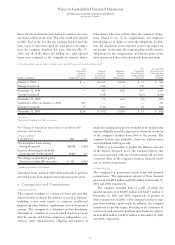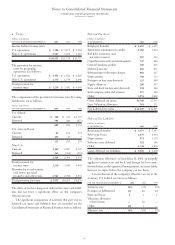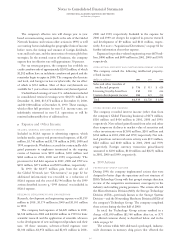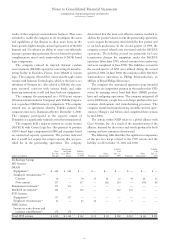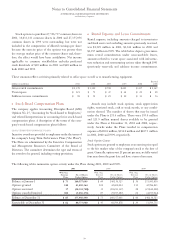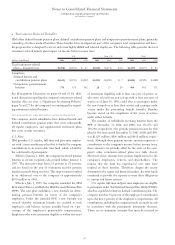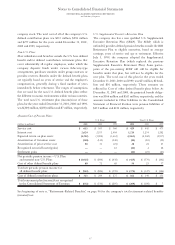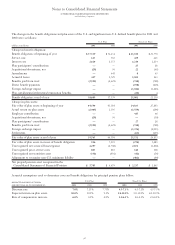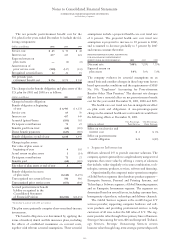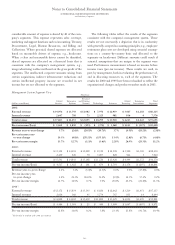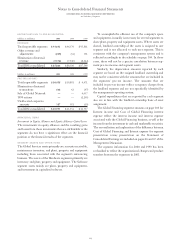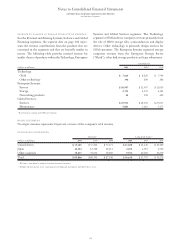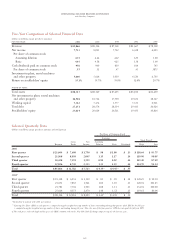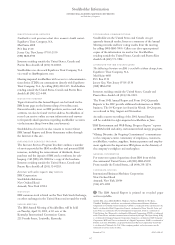IBM 2001 Annual Report Download - page 101
Download and view the complete annual report
Please find page 101 of the 2001 IBM annual report below. You can navigate through the pages in the report by either clicking on the pages listed below, or by using the keyword search tool below to find specific information within the annual report.
Notes to Consolidated Financial Statements
INTERNATIONAL BUSINESS MACHINES CORPORATION
and Subsidiary Companies
99
The company evaluates its actuarial assumptions on an
annual basis and considers changes in these long-term factors
based upon market conditions and the requirements of SFAS
No. 87, “Employers’ Accounting for Pensions.”
The change in the discount rate for the 2001 U.S. plan
year had an effect of an additional $9 million of net retire-
ment plan cost for the year ended December 31, 2001. The
change in expected return on plan assets and the discount
rate for the 2000 U.S. plan year had an effect of an additional
$195 million and $26 million of net retirement plan income,
respectively, for the year ended December 31, 2000. This
compares with an additional $46 million and $65 million of
net retirement plan cost for the year ended December 31,
1999, as a result of plan year 1999 changes in the rate of
compensation increase and the discount rate, respectively.
Funding Policy
It is the company’s practice to fund amounts for pensions
sufficient to meet the minimum requirements set forth in
applicable employee benefits laws and local tax laws. From
time to time, the company contributes additional amounts as
it deems appropriate. Liabilities for amounts in excess of
these funding levels are accrued and reported in the com-
pany’s Consolidated Statement of Financial Position. The
assets of the various plans include corporate equities, gov-
ernment securities, corporate debt securities and real estate.
Other
As described earlier in this note, the company provides
defined benefit pension plans in a number of countries. Page
98 includes an aggregation of the significant non-U.S. plans.
SFAS No. 132, “Employers’ Disclosures about Pensions and
Other Postretirement Benefits,” requires that companies
disclose the aggregate benefit obligation (BO) and plan
assets of all plans in which the BO exceeds plan assets. Similar
disclosure is required for all plans in which the accumulated
benefit obligation (ABO) exceeds plan assets. BO reflects the
present value of the pension obligation assuming salary
increases and is included in the table on the top of page 98.
The ABO reflects this obligation based upon current salary
levels (i.e., no salary increases). Accordingly, the ABO is a
subset of the BO and the plans listed under the Plans with an
ABO in excess of plan assets are also included in the amounts
for Plans with a BO in excess of plan assets. The aggregate
BO and plan assets are also disclosed for plans in which the
plan assets exceed the BO.
2001 2000
Benefit Plan Benefit Plan
(dollars in millions) Obligation Assets Obligation Assets
Plans with BO
in excess of plan
assets $«12,358 $«10,929 $«««4,209 $÷«3,919
Plans with ABO
in excess of plan
assets $«««3,041 $«««2,636 $««««««530 $÷÷÷400
Plans with assets
in excess of BO $«««9,443 $«10,602 $«16,941 $«20,915
NONPENSION POSTRETIREMENT BENEFITS
The total cost of the company’s nonpension postretirement
benefits for the years ended December 31, 2001, 2000 and
1999, were $404 million, $401 million and $371 million,
respectively. The company has a defined benefit postretire-
ment plan that provides medical, dental and life insurance
for U.S. retirees and eligible dependents. The total cost of
this plan for the years ended December 31, 2001, 2000 and
1999, was $376 million, $374 million and $342 million,
respectively. Effective July 1, 1999, the company established
a “Future Health Account (FHA) Plan” for employees who
were more than five years away from retirement eligibility.
Employees who were within five years of retirement eligibil-
ity are covered under the company’s prior retiree health
benefits plan. Under either the FHA or the preexisting plan,
there is a maximum cost to the company for retiree health
care. For employees who retired before January 1, 1992, that
maximum became effective in 2001. For all other employees,
the maximum is effective upon retirement.
Certain of the company’s non-U.S. subsidiaries have similar
plans for retirees. However, most of the retirees outside the
U.S. are covered by government-sponsored and administered
programs. The total cost of these plans for the years ended
December 31, 2001, 2000 and 1999, was $28 million, $27 mil-
lion and $29 million, respectively. At December 31, 2001 and
2000, Other liabilities in the Consolidated Statement of
Financial Position include non-U.S. postretirement benefit
liabilities of $200 million and $208 million, respectively.


